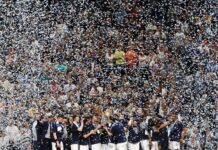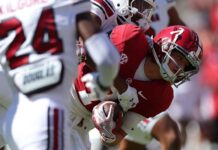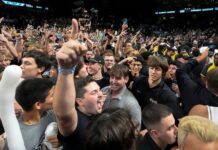[ad_1]
Attorneys negotiating a $2.78 billion settlement of class-action antitrust lawsuits against the NCAA and the nation’s largest college conferences are working to clarify parts of the deal that a judge wanted to address before deciding whether to let the landmark deal move forward.
In a hearing two weeks ago, U.S. District Judge Claudia Wilken declined to grant preliminary approval and expressed dismay at plans to regulate and potentially limit third-party payments of athletes’ names, images and similar payments from booster-funded organizations.
Wilken set a Sept. 26 deadline for attorneys on both sides to report back to him reworking parts of the settlement agreement.
“We’ve made good progress in our discussions with the NCAA on how to answer the judge’s questions and provide some clarification where the judge didn’t believe the language was clear enough on how these things would work,” said Jeffrey Kessler, one of the lead attorneys for the plaintiffs in NCAA v. House. said Tuesday. “And we feel confident that when we provide all of this information, the judge will grant preliminary approval.”
Plaintiffs in three antitrust lawsuits involving the NCAA and athlete compensation, including the five major conferences (Big Ten, Big 12, Atlantic Coast, Pac-12 and Southeast), agreed to a settlement in May. The settlement provides nearly $3 billion in damages to current and former college athletes who were denied the opportunity to cash in on their fame. It also sets up a groundbreaking revenue sharing system that will allow schools to direct their athletes more than $20 million per year.
Wilken’s issue with the part of the settlement that would try to rein in booster payments to athletes under the guise of a NIL deal — an element of the deal that was a high priority for conferences — appears to represent the biggest obstacle to getting it approved.
Steve Berman, the plaintiffs’ other lead attorney, declined to provide details on how Wilken’s questions are being addressed, but suggested there would be no significant changes. “It won’t be drastic, no,” he told the AP.
Kessler said the two sides haven’t settled on exactly how the proposed sanctions on certain third-party NIL agreements will be re-presented to the judge.
“But our belief is that we need to clarify that provision so the judge understands what it does and doesn’t do compared to what the NCAA rules already prohibit,” Kessler said.
Berman said there are concerns that it could be a deal-breaker if the judge isn’t satisfied and the only option is to remove these proposed restrictions.
“But I’m not sure the judge appreciated the money dynamic,” Berman said. “There’s a huge amount of money coming to students that wasn’t there before. So I think we need to refocus on that.”
The NCAA and conferences hope the settlement can bring some clarity and structure to an initiative that has been under constant legal and political attack for years. The settlement won’t end all legal challenges in college sports, but it will provide a new way of doing business and a framework that leaders can then bring to Congress in hopes of getting support in the form of a federal law.
State legislators and politicians continue to add a confusing patchwork of rules across the country. On Tuesday, Georgia Gov. Brian Kemp signed an executive order that gives the state’s schools the power to pay athletes directly without interference from the NCAA or the conference. The order is similar to laws in other states that protect schools from NCAA enforcement.
As for the settlement, it’s unclear when Wilken will rule on the preliminary approval request after receiving answers to his questions late next week.
“I think we can make it clearer,” Berman said. “That’s what we’re working on.”
[ad_2]











